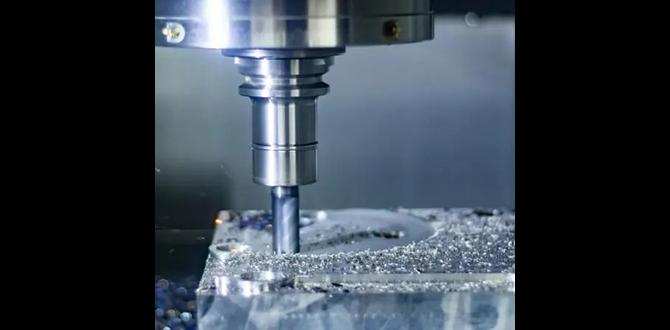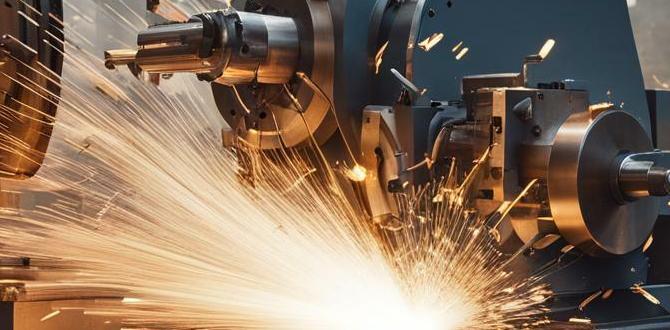Carbide end mills, particularly those with a reduced neck and specific flute design, are your best bet at significantly minimizing HDPE deflection. Choosing the right diameter and ensuring proper feed rates and speeds will keep your cuts clean and precise.
Hey there, fellow makers! Ever tried to mill High-Density Polyethylene (HDPE) and ended up with a wobbly, messy cut? That frustrating deflection is a common hurdle, especially when working with softer plastics like HDPE. It’s like the material pushes back more than you’d expect, making your perfectly planned cuts a bit of a mess. But don’t worry, it’s a challenge we can overcome with the right tools and techniques. Today, we’re going to explore a proven way to tackle this head-on, ensuring you get those crisp, clean edges you’re aiming for. Get ready to make HDPE milling much smoother and more predictable!
Why Does HDPE Deflect So Much?
HDPE, or High-Density Polyethylene, is a fantastic material for many projects. It’s durable, UV resistant, and easy to weld. However, when it comes to machining, particularly with milling operations, it can present a unique challenge: deflection.
This happens because HDPE is a relatively soft and flexible plastic. When a milling tool, like an end mill, encounters the material, it exerts a force. In softer materials, this force can cause the plastic to bend or “deflect” away from the cutting edge. This deflection can lead to several problems:
Oversized or Undersized Features: The tool might not cut to the exact dimension intended because the material deflects.
Rough Surface Finish: The material bending and springing back can leave a rough or uneven surface.
Chatter and Vibration: Deflection can cause the tool to vibrate, leading to a poor finish and potentially damaging the tool or workpiece.
Tool Breakage: In severe cases, excessive deflection can put too much stress on the end mill, leading to breakage.
Understanding why it deflects is the first step to controlling it. Compared to harder materials like aluminum or steel, HDPE’s lower hardness and higher flexibility mean it’s more susceptible to deformation under cutting forces. Factors like tool geometry, cutting speed, feed rate, and depth of cut all play a role in how much deflection occurs.
The Right Tool for the Job: Carbide End Mills
When milling HDPE, the type of end mill you choose is critical. While various end mills can technically cut plastic, certain characteristics make a carbide end mill a superior choice for minimizing deflection.
Why Carbide?
Carbide (specifically tungsten carbide) is an extremely hard and wear-resistant material. This inherent hardness allows carbide end mills to maintain a sharp cutting edge for longer, even at higher speeds and with tougher materials. For HDPE, this means:
Sharper Edge: A sharper edge cuts more cleanly, requiring less force and therefore causing less deflection.
Heat Resistance: Milling, even plastics, generates heat. Carbide handles heat better than high-speed steel (HSS), which can soften and lose its edge. This makes for more consistent cutting.
Rigidity: Carbide itself is a more rigid material than HSS, meaning the tool is less likely to flex under load.
The “Reduced Neck” Advantage
This is where things get particularly interesting for HDPE. A “reduced neck” end mill features a section behind the cutting flutes that is slightly smaller in diameter. This design is often used in areas where clearance is an issue, but for HDPE milling, it offers a significant advantage in reducing deflection.
Here’s why a reduced neck end mill is so effective for HDPE:
1. Less Drag from the Body: As the end mill cuts, not only the flutes are in contact with the material, but also the body of the end mill. On a standard end mill, this body contact, even if minimal, can cause drag and contribute to deflection. With a reduced neck, the body behind the flutes is smaller, meaning less material is in contact with the workpiece during the cut. This reduced drag means less force pushing against the material.
2. Improved Chip Evacuation: The slightly larger space created by the reduced neck can sometimes aid in chip evacuation, preventing chips from packing up and causing further friction and deflection.
3. Flexibility in Design: Manufacturers specifically design some reduced neck end mills not just for clearance but with enhanced flute geometry optimized for plastics, which further improves performance.
When searching for the right tool, look for terms like “plastic cutting end mill,” “single flute,” or “two flute” with a “reduced neck” or “swirl flute” design. For HDPE, particularly with our target keyword of “carbide end mill 3/16 inch 3/8 shank reduced neck for hdpe minimize deflection,” a 3/16 inch diameter carbide end mill with a 3/8 inch shank and a reduced neck is a strong candidate. The smaller diameter end mill itself will generate less cutting force than a larger one, and the reduced neck design will further minimize drag and deflection.
Optimizing Your Cut: Speeds, Feeds, and Depth of Cut
Having the right tool is only half the battle. You also need to set up your milling machine correctly. This means finding the sweet spot for your cutting speed, feed rate, and depth of cut.
Cutting Speed and Spindle RPM
Cutting speed refers to the speed at which the cutting edge of the end mill moves through the material, usually measured in surface feet per minute (SFM) or meters per minute (m/min). Spindle RPM is what you control on your machine to achieve the desired cutting speed.
For HDPE, you generally want to use higher spindle speeds compared to metals. This is because plastics melt more easily, and a faster spindle speed means the tool spends less time in any one spot, reducing heat buildup.
General Guideline: For a 3/16 inch carbide end mill in HDPE, you might start in the range of 15,000 to 25,000 RPM. It’s always best to consult the end mill manufacturer’s recommendations if available.
The “Feel”: If you’re seeing melting or chips are welding to the cutter, your RPM is likely too low or your feed rate is too slow. If you hear excessive screaming or see a very poor finish, your RPM might be too high or your feed rate too aggressive.
Feed Rate – The Critical Partner to RPM
The feed rate is how fast the end mill is advanced into the material, typically measured in inches per minute (IPM) or millimeters per minute (mm/min). This is arguably the MOST critical factor in minimizing deflection.
The goal with feed rate in plastics is to ensure that each flute of the end mill takes a chip of appropriate size. If the feed rate is too slow, the end mill rubs against the plastic rather than cutting it efficiently, generating extra heat and increasing deflection. If it’s too fast, you risk overloading the tool, increasing deflection, and potentially breaking the tool or producing poor surface finish.
Chip Load: A good way to think about feed rate is through “chip load.” Chip load is the thickness of the chip removed by each cutting edge per revolution. For plastics like HDPE, you want a chip that is substantial enough to be cleared easily but not so thick that it overloads the tool.
For a 3/16″ Carbide End Mill: A good starting chip load for HDPE might be in the range of 0.002″ to 0.005″ per flute.
Calculating Feed Rate: Feed Rate (IPM) = RPM × Number of Flutes × Chip Load (inches/flute).
Let’s say you’re running at 20,000 RPM with a 2-flute end mill and aiming for a chip load of 0.003″ per flute:
Feed Rate = 20,000 RPM × 2 flutes × 0.003 in/flute = 120 IPM.
Listen and Observe: A good feed rate will produce a clean, wispy chip. Too slow, and you get fine powder or melting. Too fast, and you get jamming or a rough finish. Adjust your feed rate based on what you see and hear.
Depth of Cut (DOC) – Small and Steady Wins the Race
The depth of cut is how deep the end mill plunges into the material on each pass. For HDPE, it’s best to take lighter depths of cut. This reduces the forces acting on the tool and the workpiece, significantly minimizing deflection.
Light DOC is Key: For a 3/16 inch end mill, you might try a depth of cut between 0.060″ and 0.125″ (1/16″ to 1/8″) per pass.
Climb vs. Conventional Milling: For plastics, climb milling is often preferred when possible. In climb milling, the cutter rotates in the same direction as it feeds into the material. This generally results in a better surface finish and less deflection compared to conventional milling, where the cutter rotates against the feed direction.
Using Tabbed Machining
When cutting out shapes from a sheet of HDPE, you need a way to hold the part in place. If you cut all the way around, the piece will fly off once the last connection is severed. Tabs are small sections of material left uncut, holding the part to the main sheet until you can manually remove it.
How it Helps Deflection: By leaving tabs, you maintain continuous contact between the tool arbor and the material for a longer portion of the cut. This can help stabilize the part and the tool, indirectly reducing deflection in the critical areas you are cutting.
Placement is Key: Strategically place tabs where they won’t interfere with your final part’s functionality or aesthetics. You can easily break them off later with a utility knife, chisel, or by carefully sanding them down.
Choosing the Right End Mill Flute Count
The number of flutes on an end mill also influences its performance in plastics like HDPE.
Single Flute End Mills: These are often excellent for plastics. They offer the most aggressive chip evacuation because half of the end mill is essentially open space. This allows for higher feed rates and can help reduce heat buildup. Their simpler geometry can also contribute to less drag.
Two Flute End Mills: Offer a good balance. They provide better cutting action than a single flute for some materials and are more rigid. They are a very common and effective choice for HDPE, especially general-purpose ones.
Multi-Flute End Mills (3+): These are generally better suited for harder materials where chip evacuation isn’t as critical, and rigidity is paramount (like metals). For HDPE, more flutes can lead to poorer chip evacuation and increased friction, potentially causing more deflection and melting.
For HDPE, starting with a single or two-flute carbide end mill is generally recommended. The “carbide end mill 3/16 inch 3/8 shank reduced neck” we’ve been discussing would likely be a 1 or 2-flute tool.
What to Look for in an End Mill for HDPE
When you’re at the store or browsing online, keep these in mind when selecting an end mill for HDPE:
Material: Carbide (tungsten carbide) is preferred for its hardness and wear resistance.
Coating: While not strictly necessary for HDPE, some coatings such as TiN (Titanium Nitride) can offer slight improvements in lubricity and wear resistance, helping chips slide off more easily. However, for HDPE, a sharp, uncoated carbide end mill is often sufficient.
Flute Design: Look for “plastic specific” end mills. These often have highly polished flutes and a zero or slightly positive rake angle. A polished flute finish reduces friction and adhesion of melted plastic.
Helix Angle: A steeper helix angle (e.g., 30-45 degrees) can help with faster material removal and better chip evacuation. Very high helix angles can sometimes be more prone to chatter, so a moderate steepness is often a good compromise.
Reduced Neck: As discussed, this is a key feature for reducing drag and deflection.
A Recommended Carbide End Mill for HDPE: The “Reduced Neck”
Let’s talk specifics about the type of tool that best addresses our deflection problem. For a 3/16 inch diameter cutting tool, focusing on a “reduced neck” design with a carbide material is a smart move.
Example Specification:
Type: Carbide End Mill
Diameter: 3/16 inch
Shank Diameter: 3/8 inch (provides good rigidity for holding power)
Number of Flutes: 1 or 2 (preferred for plastics)
Neck Relief: Yes, reduced neck design is crucial. This means the body of the tool tapers back behind the cutting flutes, allowing the body to pass through the cut without dragging unnecessarily.
Helix Angle: Moderate (e.g., 30-45 degrees)
Specific Features for Plastics: Polished flutes, possibly a single-edge design if specifically for plastics.
This type of end mill is engineered to provide a clean cut with minimal friction and drag, which directly combats the tendency of HDPE to deflect. The smaller 3/16 inch diameter itself means less mass and less inherent cutting force compared to a larger end mill, making it easier to control. The 3/8 inch shank offers good clamping surface in your collet or tool holder, providing rigidity.
Where to Find Them
Reputable tool manufacturers and suppliers offer these specialized end mills. Look for brands known for their quality cutting tools. Sometimes these might be listed under categories like “plastic routers” or “specialty cutters.” Websites dedicated to machining supplies or CNC components are good places to start searching. Online retailers like Amazon, McMaster-Carr, and specialized machining supply sites are excellent resources.
Step-by-Step Guide to Minimizing HDPE Deflection
Here’s a practical walkthrough to help you achieve precise cuts using your carbide end mill on HDPE.
Step 1: Secure Your Workpiece
Clamping is Crucial: HDPE is relatively light and can shift. Use robust clamps (like T-track clamps or toe clamps) to firmly secure your sheet to the machine bed. Ensure there are no gaps between the HDPE and the bed.
Consider Support: If you’re cutting large sheets or thin sections, consider adding support material underneath. A sacrificial layer of MDF or plywood can help prevent the entire sheet from flexing excessively under the applied forces and can also provide a better surface for the vacuum if you’re using a dust collection system.
Step 2: Select and Inspect Your End Mill
Choose Wisely: Use the recommended type of end mill (3/16″ carbide, 2-flute, reduced neck is a great starting point).
Check for Damage: Before mounting, inspect your end mill for any nicks, dullness, or signs of wear. A sharp, undamaged tool is essential for a clean cut and minimal deflection.
Step 3: Set Up Your Machine Parameters
Install the End Mill: Secure the end mill in your collet or tool holder. Ensure it’s seated properly and tightened securely.
Determine Spindle Speed (RPM): Start with the higher end of the recommended range for plastics. For a 3/16″ carbide end mill, 15,000 – 25,000 RPM is a good starting point.
Calculate Feed Rate: This is key. Using the formula: Feed Rate (IPM) = RPM × Number of Flutes × Chip Load (inches/flute). Aim for a chip load of 0.002″ – 0.005″ for HDPE. If in doubt, start conservatively and increase if the cut is too slow or not clean.
Set Depth of Cut (DOC): Begin with a light depth of cut, around 0.060″ to 0.125″. You can always take multiple passes to reach your final depth.
Direction of Cut: Prefer climb milling if your machine allows and the geometry is suitable for it.
Step 4: Perform a Test Cut
“Air Cut” First: If possible, run your program without the material in place (or significantly above it). This checks for collision issues and verifies your toolpath.
Test on Scrap: Always start with a piece of scrap HDPE. Make a simple cut (like a line or a small square) and observe the results.
What to Look For:
Chip Formation: Are you getting clean, wispy chips, or fine powder/melted plastic? Wispy chips are good.
Sound: Does the cut sound smooth and consistent, or is it chattering, screaming, or struggling?
Deflection: Does the part visibly flex away from the tool? Is the resulting cut precise?
Surface Finish: Is it smooth and clean, or rough and gummy?
Step 5: Adjust and Recut
Too Much Melt/Friction: Increase RPM slightly, or increase feed rate slightly (if chip load was too small). Ensure depth of cut isn’t too large.
Chattering/Tool Struggling: Decrease feed rate slightly, or decrease RPM slightly. Ensure depth of cut isn’t too large.
Visible Deflection: This is the main issue.
Increase Feed Rate: This is often the first adjustment. A slightly faster feed rate forces the tool to cut rather than rub, leading to a cleaner chip and less deflection.
Decrease Depth of Cut: If increasing feed rate doesn’t help, reducing the DOC will lessen the cutting forces.
Ensure Tool is Sharp: A duller tool requires more force to cut.
* Consider Climb Milling: If you were using conventional milling, switch to climb milling.
Step 6: Cut Your Final Part
Once you’ve dialed in your settings on scrap material, you can proceed with cutting your actual part. Continue to monitor the cut for any unexpected behavior. Utilize tabs to hold your workpiece securely until the final separation.




